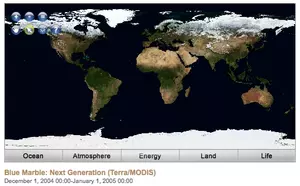Initial Publication Date: November 22, 2010
Lab 5: Air, Water, Land, & Life: A Global Perspective
Introduction
Image source: NASA NEO
If we were only able to observe the Earth from the ground, we would never be able to get a truly global view of the Earth system and the interactions among air, water, land, and life. The single best vantage point from which to learn the most about Earth, is from high above the surface. Fortunately, satellite technology has afforded us the ability to view Earth from the unique perspective of space.Satellites acquire new images of Earth all the time. Images from Earth-observing satellites show us enough of the Earth at once that we can see large-scale phenomena and interactions such as the spread of air pollution, damage from earthquakes, volcanoes, fires, or the entire span of a hurricane. Satellites can also track temporal changes to show things like deforestation, sea level rise, or ozone depletion. Observing Earth over time from space will enable us to evaluate the progression of climate change and the global impacts of human activity.
In Part A of this lab, you will examine a variety of images and maps of the whole Earth in order to identify the major components of the Earth system at the global scale. In Part B, you will play a game that will help you better understand the water cycle and its importance within the Earth system. You will then describe the water cycle at the global scale in greater detail, identify the components through which water passes and the processes that move it, and draw an abstract diagram.
After completing this investigation, you should be able to:
- use images and data about the whole Earth to identify the major components of the Earth system at the global scale;
- describe the pathway of water among the four components of the Earth system, as an example of ways they are interconnected; and
- translate your understanding of that pathway into an abstract diagram.
Keeping Track of What You Learn
Throughout these labs, you will find two kinds of questions.
- Checking In questions are intended to keep you engaged and focused on key concepts and to allow you to periodically check if the material is making sense. These questions are often accompanied by hints or answers to let you know if you are on the right track.
- Stop and Think questions are intended to help your teacher assess your understanding of the key concepts and skills you should be learning from the lab activities and readings.
Your teacher will let you know which answers you should record and turn in.


